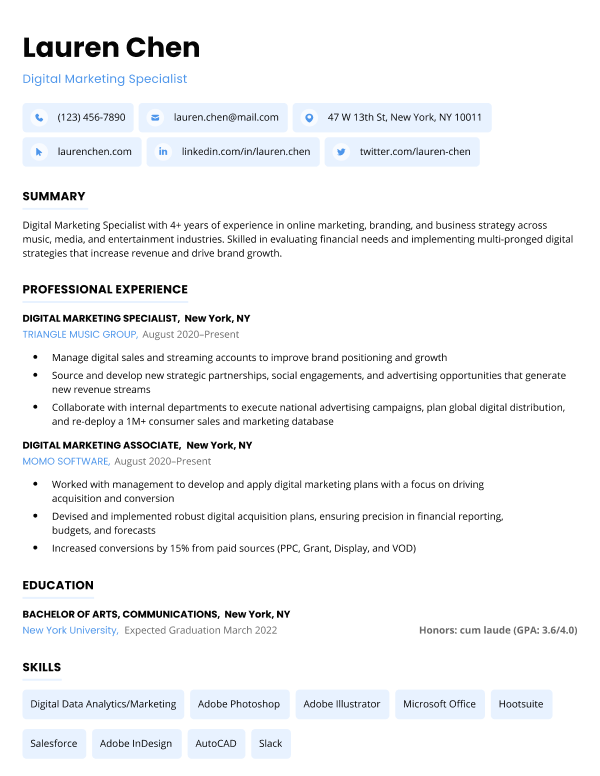For operational security reasons, you don’t want to disclose too much about your security clearance to employers, but it’s still appropriate to list the basics of your clearance so employers know they won’t need to spend extra time getting you cleared.
How to put a security clearance on your resume
In the header:
Jonathan Whitman
Active U.S Secret Clearance
In a separate section:
Clearances
Top Secret Clearance
October 2022–present
Decide if including your security clearance is necessary
Security clearance isn’t just for secret agents. While often associated with high-ranking government and military personnel, security clearance can be a requirement for many civilian jobs as well.
Unlike other certifications, government security clearances can only be obtained when you are hired for a position requiring that specific level of clearance.
When to list a security clearance on your resume
Disclosing your security clearance can provide advantages when writing a federal government resume or a resume for a private sector job.
A job will require security clearance if it involves:
- National security
- Federal law enforcement
- Intelligence
- Foreign affairs
- Any other sensitive government operations
When applying for a job that requires the same type of clearance you have, putting it on your resume shows hiring managers that you can start immediately without undergoing a lengthy background check.
The transferability of a security clearance can be limited based on factors like the clearance level and any gaps in employment during the clearance period.
Private sector jobs in areas like defense, intelligence, cybersecurity, and business analysis may also require security clearance. Because the pool of cleared candidates is smaller outside of government, highlighting your clearance status can make you stand out to private employers.
When not to list a security clearance on your resume
There are circumstances where it would be unnecessary or inappropriate to include your security clearance on your resume. For example:
If it hasn’t been approved yet
Including an in-process or pending security clearance on your resume is not recommended.
Security clearances involve extensive vetting and being granted your clearance isn’t guaranteed, so you don’t want to mislead hiring managers by highlighting a clearance you don’t actually have yet.
If it expired a long time ago
You should avoid listing a very outdated security clearance. If your clearance lapsed many years ago, it doesn’t say much about your current qualifications.
Hiring managers may view long-expired clearances as irrelevant or wonder why you haven’t maintained an active clearance status. In this situation, it’s better to focus on more recent experience and skills.
If it has no relevance to the role you’re applying for
While a security clearance might still impress many employers even if it’s not required, you should consider the specific job duties and industry you’re applying for work in.
Clearance is more relevant for positions involving data privacy, confidential information, regulated access, or ethics. However, creative fields like media, marketing, or design may see an unrelated clearance as irrelevant information.
Our free-to-use resume builder can make you a resume in as little as 5 minutes. Just pick the template you want, and our software will format everything for you.
Specify the type of security clearance you have
There are three basic levels of security clearance:
| Type of clearance | Level | Access | Must be renewed |
|---|---|---|---|
| Confidential | Lowest level | Provides access to information that could be harmful to national security if disclosed | Every 15 years |
| Secret | Mid-level | Grants access to information that could seriously jeopardize national security if leaked | Every 10 years |
| Top secret | Highest level | Allows access to highly sensitive information that could severely compromise national security if made public | Every 5 years |
There are specialized clearances issued by the Department of Energy, like “Q” for nuclear weapons information and “L” for nuclear-related intelligence. These should only be listed on your resume if specifically required for a role. Otherwise, your baseline clearance level (confidential, secret, or top secret) is sufficient.
There are additional security distinctions beyond a standard security clearance, like Special Access Programs (SAP) and Sensitive Compartmented Information (SCI), that allow a more granular level of control over sensitive information.
You should avoid advertising past access to SAPs or SCIs on your resume. Given the highly sensitive nature of these programs, you should only include these details if they’re explicitly required for a position.
It is usually enough to list your baseline security clearance level. However, if the job posting specifically requires SCI or SAP eligibility, you can mention it, but don’t name specific programs or any other details that may be classified.
Generally, you should only include the following details:
- Level of security clearance
- Date expired (if inactive)
When deciding what to include on your resume, research any applicable government regulations first. Agencies like the Department of State, the Department of Defense, and the National Security Agency may have published online guidelines regarding proper security clearance disclosures.
List it at the top or in the certifications section of your resume
For maximum impact, feature your security clearance prominently at the top of your resume. Alternatively, you can include it in its own designated section.
Example of a security clearance at the top of a resume
Your security clearance can go in the header section next to your name and contact information, like this:
You could also put it in your resume summary, like this:
Cybersecurity Analyst with over 4 years of experience safeguarding classified government networks and sensitive data. Maintain an active secret security clearance. Expertise in threat detection, analysis, and incident response. Seeking to leverage clearance status and cyber defense skills to further strengthen the U.S. intelligence community’s information security.
Example of a security clearance in a separate section
If you hold more than one relevant security clearance, an inactive clearance, or you would just like to list your clearance near your other training, you can include it in a separate section, like this:

Build your resume in minutes
Use an AI-powered resume builder and have your resume done in 10 minutes. Just select your template and our software will guide you through the process.

















